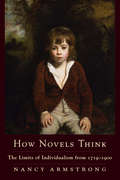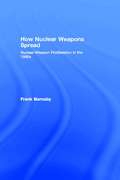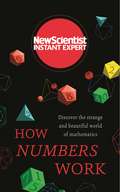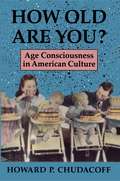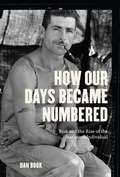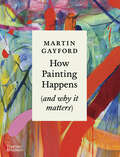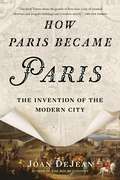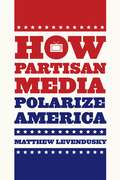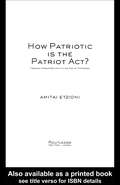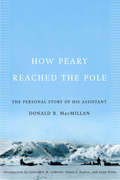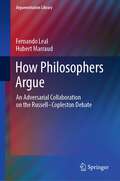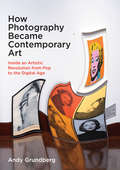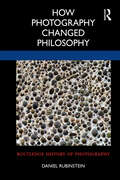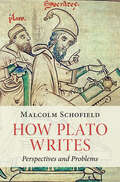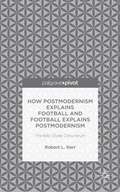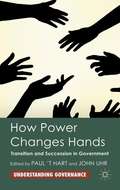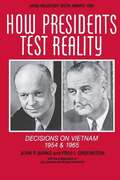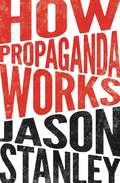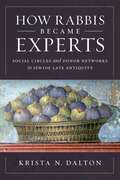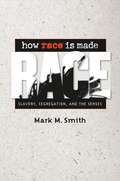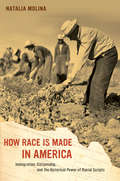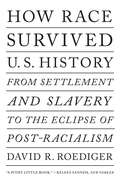- Table View
- List View
How Novels Think: The Limits of Individualism from 1719-1900
by Nancy ArmstrongNancy Armstrong argues that the history of the novel and the history of the modern individual are, quite literally, one and the same. She suggests that certain works of fiction created a subject, one displaying wit, will, or energy capable of shifting the social order to grant the exceptional person a place commensurate with his or her individual worth. Once the novel had created this figure, readers understood themselves in terms of a narrative that produced a self-governing subject.In the decades following the revolutions in British North America and France, the major novelists distinguished themselves as authors by questioning the fantasy of a self-made individual. To show how novels by Defoe, Austen, Scott, Brontë, Dickens, Eliot, Hardy, Haggard, and Stoker participated in the process of making, updating, and perpetuating the figure of the individual, Armstrong puts them in dialogue with the writings of Locke, Hume, Rousseau, Malthus, Darwin, Kant, and Freud. Such theorists as Althusser, Balibar, Foucault, and Deleuze help her make the point that the individual was not one but several different figures. The delineation and potential of the modern subject depended as much upon what it had to incorporate as what alternatives it had to keep at bay to address the conflicts raging in and around the British novel.
How Now Shall We Live
by Charles Colson Nancy PearceyChristianity is more than a personal relationship with Jesus Christ. It is also a worldview that not only answers life's basic questions--Where did we come from, and who are we? What has gone wrong with the world? What can we do to fix it?
How Nuclear Weapons Spread: Nuclear-Weapon Proliferation in the 1990s
by Frank BarnabyIn How Nuclear Weapons Spread, Frank Barnaby examines the far-reaching effects - both beneficial and detrimental - of nuclear weapons. He looks in detail at the nuclear programmes of Third World countries, including India, Israel and Pakistan which have or could very rapidly acquire nuclear weapons, and assesses the nuclear capabilities of countries such as Iran, Iraq and North Korea. He also considers the alarming possibility that terrorists might obtain nuclear weapons, and considers methods of controlling their spread.
How Numbers Work: Discover the strange and beautiful world of mathematics (Instant Expert)
by New ScientistThink of a number between one and tenNo, hang on, let's make this interesting. Between zero and infinity. Even if you stick to the whole numbers, there are a lot to choose from - an infinite number in fact. Throw in decimal fractions and infinity suddenly gets an awful lot bigger (is that even possible?) And then there are the negative numbers, the imaginary numbers, the irrational numbers like p which never end. It literally never ends.The world of numbers is indeed strange and beautiful. Among its inhabitants are some really notable characters - pi, e, the square root of minus two and the famous golden ratio to name just a few. Prime numbers occupy a special status. Zero is very odd indeed. And even some apparently common-or-garden integers such as 37 have special properties. Adventures In Mathematics takes a tour of this mind-blowing but beautiful world of numbers and the mathematical rules that connect them. Find out mathematicians' favourite numbers, and the ones they are afraid of (spoiler: it isn't 13). Discover the incredible connection between numbers and the rules of nature. And learn some amazing mathematical tricks that will keep you amused for hours.
How Old Are You?: Age Consciousness in American Culture
by Howard P. ChudacoffMost Americans take it for granted that a thirteen-year-old in the fifth grade is "behind schedule," that "teenagers who marry "too early" are in for trouble, and that a seventy-five-year-old will be pleased at being told, "You look young for your age." Did an awareness of age always dominate American life? Howard Chudacoff reveals that our intense age consciousness has developed only gradually since the late nineteenth century. In so doing, he explores a wide range of topics, including demographic change, the development of pediatrics and psychological testing, and popular music from the early 1800s until now. "Throughout our lifetimes American society has been age-conscious. But this has not always been the case. Until the mid-nineteenth century, Americans showed little concern with age. The one-room schoolhouse was filled with students of varied ages, and children worked alongside adults.... [This is] a lively picture of the development of age consciousness in urban middle-class culture." --Robert H. Binstock, The New York Times Book Review "A fresh perspective on a century of social and cultural development."--Michael R. Dahlin, American Historical Review
How Our Days Became Numbered: Risk and the Rise of the Statistical Individual
by Dan BoukLong before the age of "Big Data" or the rise of today's "self-quantifiers," American capitalism embraced "risk"--and proceeded to number our days. Life insurers led the way, developing numerical practices for measuring individuals and groups, predicting their fates, and intervening in their futures. Emanating from the gilded boardrooms of Lower Manhattan and making their way into drawing rooms and tenement apartments across the nation, these practices soon came to change the futures they purported to divine.How Our Days Became Numbered tells a story of corporate culture remaking American culture--a story of intellectuals and professionals in and around insurance companies who reimagined Americans' lives through numbers and taught ordinary Americans to do the same. Making individuals statistical did not happen easily. Legislative battles raged over the propriety of discriminating by race or of smoothing away the effects of capitalism's fluctuations on individuals. Meanwhile, debates within companies set doctors against actuaries and agents, resulting in elaborate, secretive systems of surveillance and calculation. Dan Bouk reveals how, in a little over half a century, insurers laid the groundwork for the much-quantified, risk-infused world that we live in today. To understand how the financial world shapes modern bodies, how risk assessments can perpetuate inequalities of race or sex, and how the quantification and claims of risk on each of us continue to grow, we must take seriously the history of those who view our lives as a series of probabilities to be managed.
How Painting Happens (and Why it Matters)
by Martin GayfordDrawing on decades of conversations with practicing artists, Martin Gayford offers intimate insight into the practice, meaning, and potential of painting. Painting is an almost inconceivably ancient activity that remains vigorously alive in the twenty-first century. Every successful painting creates a new world, which we inhabit for as long as we care to look at it. Paintings can incorporate profound ideas and paradoxes that can be grasped without words. For those who dedicate themselves to it, the art of painting can become an all-consuming, lifelong obsession. It is a subject on which painters themselves are often the most incisive commentators. Martin Gayford’s riveting and richly illustrated book deftly brings together numerous artists’ voices, past and present. It draws on a trove of conversations conducted over more than three decades with artists including Frank Auerbach, Gillian Ayres, Frank Bowling, Cecily Brown, Peter Doig, Lucian Freud, Katharina Fritsch, David Hockney, Claudette Johnson, R. B. Kitaj, Lee Ufan, Paula Rego, Gerhard Richter, Bridget Riley, Jenny Saville, Frank Stella, Luc Tuymans, Zeng Fanzhi, and many more. Here too is Vincent van Gogh on Rembrandt, John Constable on Titian, Francis Bacon on Velázquez, Lee Krasner on Pollock, and Jean-Michel Basquiat on Picasso. We hear the personal reflections of these artists on their chosen medium; how and why they paint; how they came to the practice; the influence of fellow painters; and how they find creative sustenance and inspiration in their art. How Painting Happens crosses the centuries to give us a wealth of insights into the endlessly compelling phenomenon of painters and painting.
How Paris Became Paris: The Invention of the Modern City, First U.S. Edition
by Joan DejeanAt the beginning of the seventeenth century, Paris was known for isolated monuments but had not yet put its brand on urban space. Like other European cities, it was still emerging from its medieval past. But in a mere century Paris would be transformed into the modern and mythic city we know today. <P><P>Though most people associate the signature characteristics of Paris with the public works of the nineteenth century, Joan DeJean demonstrates that the Parisian model for urban space was in fact invented two centuries earlier, when the first complete design for the French capital was drawn up and implemented. As a result, Paris saw many changes. It became the first city to tear down its fortifications, inviting people in rather than keeping them out. Parisian urban planning showcased new kinds of streets, including the original boulevard, as well as public parks and the earliest sidewalks and bridges without houses. Venues opened for urban entertainment of all kinds, from opera and ballet to a pastime invented in Paris, recreational shopping. Parisians enjoyed the earliest public transportation and street lighting, and Paris became Europe's first great walking city. <P><P>A century of planned development made Paris both beautiful and exciting. It gave people reasons to be out in public as never before and as nowhere else. And it gave Paris its modern identity as a place that people dreamed of seeing. By 1700, Paris had become the capital that would revolutionize our conception of the city and of urban life.
How Partisan Media Polarize America
by Matthew LevenduskyForty years ago, viewers who wanted to watch the news could only choose from among the major broadcast networks, all of which presented the same news without any particular point of view. Today we have a much broader array of choices, including cable channels offering a partisan take. With partisan programs gaining in popularity, some argue that they are polarizing American politics, while others counter that only a tiny portion of the population watches such programs and that their viewers tend to already hold similar beliefs. <P><P> In How Partisan Media Polarize America, Matthew Levendusky confirms--but also qualifies--both of these claims. Drawing on experiments and survey data, he shows that Americans who watch partisan programming do become more certain of their beliefs and less willing to weigh the merits of opposing views or to compromise. And while only a small segment of the American population watches partisan media programs, those who do tend to be more politically engaged, and their effects on national politics are therefore far-reaching. <P>< In a time when politics seem doomed to partisan discord, How Partisan Media Polarize America offers a much-needed clarification of the role partisan media might play.
How Patriotic is the Patriot Act?: Freedom Versus Security in the Age of Terrorism
by Amitai EtzioniIn this short book, Etzioni, the well-known and respected public intellectual and communitarian thinker, charts a middle course, or third way 'between those who are committed to shore up our liberties but blind to the needs of public security, as well as those who never met a right they are not willing to curtail to give authorities an even freer hand.' This book will prove a useful guide for citizens looking for a thought provoking, well-reasoned and sober analysis of one of the hot button issues of our time.
How Peary Reached the Pole
by Donald MacmillanIn 1934 Donald B. MacMillan, an accomplished explorer, wrote about his early career as a member of Robert E. Peary's 1908-09 North Pole Expedition. Now available for the first time since its original publication, this expanded edition of How Peary Reached the Pole features a biography of MacMillan and thirty-six images from his hand-tinted lantern slides. MacMillan used the journal he kept during the expedition to provide an intimate view of day-to-day activities and relationships with other members of the party, detailing how he learned to drive dog teams, camp in sub-zero temperatures, and travel safely across the ice-covered Polar Sea. MacMillan's experiences and deep admiration for Peary's methods, leadership, and many accomplishments make for fascinating reading. How Peary Reached the Pole allows us to see Arctic landscapes and Inughuit culture as MacMillan experienced them, providing a perspective from which to consider the northern environmental and cultural issues that continue to concern individuals and nations today, one hundred years after Peary's historic expedition.
How Peary Reached the Pole: The Personal Story of His Assistant
by Donald MacMillanIn 1934 Donald B. MacMillan, an accomplished explorer, wrote about his early career as a member of Robert E. Peary's 1908-09 North Pole Expedition. Now available for the first time since its original publication, this expanded edition of How Peary Reached the Pole features a biography of MacMillan and thirty-six images from his hand-tinted lantern slides. MacMillan used the journal he kept during the expedition to provide an intimate view of day-to-day activities and relationships with other members of the party, detailing how he learned to drive dog teams, camp in sub-zero temperatures, and travel safely across the ice-covered Polar Sea. MacMillan's experiences and deep admiration for Peary's methods, leadership, and many accomplishments make for fascinating reading. How Peary Reached the Pole allows us to see Arctic landscapes and Inughuit culture as MacMillan experienced them, providing a perspective from which to consider the northern environmental and cultural issues that continue to concern individuals and nations today, one hundred years after Peary's historic expedition.
How Philosophers Argue: An Adversarial Collaboration on the Russell--Copleston Debate (Argumentation Library #41)
by Fernando Leal Hubert MarraudThis volume presents a double argumentative analysis of the debate between Bertrand Russell and Frederick Copleston on the existence of God. It includes an introduction justifying the choice of text and describing the historical and philosophical background of the debate. It also provides a transcript of the debate, based in part on the original recording.The argumentative analyses occupy Parts I and II of the book. In Part I the argumentative process is analysed by means of the ideal model of critical discussion, the workhorse of pragma-dialectics. Part I shows how the two parties go through the four stages of a critical discussion. It highlights the questions raised over and beyond the presiding question of whether God exists and examines almost a hundred questions that are raised. Many are left in the air, whereas a few others give rise to sundry sub-discussions or meta-dialogues. In Part II the theoretical framework of argument dialectic is put to work: argument structures are identified by means of punctuation marks, argumentative connectors and operators, allowing to see the argumentative exchange as the collaborative construction of a macro-argument. Such a macro-argument is both a joint product of the arguers and a complex structure representing the dialectical relationships between the individual arguments combined in it. Finally, the complementarity of the two approaches is addressed. Thus the book can be described as an exercise in adversarial collaboration.
How Photography Became Contemporary Art: Inside an Artistic Revolution from Pop to the Digital Age
by Andy GrundbergA leading critic&’s inside story of &“the photo boom&” during the crucial decades of the 1970s and 80s When Andy Grundberg landed in New York in the early 1970s as a budding writer, photography was at the margins of the contemporary art world. By 1991, when he left his post as critic for the New York Times, photography was at the vital center of artistic debate. Grundberg writes eloquently and authoritatively about photography&’s &“boom years,&” chronicling the medium&’s increasing role within the most important art movements of the time, from Earth Art and Conceptual Art to performance and video. He also traces photography&’s embrace by museums and galleries, as well as its politicization in the culture wars of the 80s and 90s. Grundberg reflects on the landmark exhibitions that defined the moment and his encounters with the work of leading photographers—many of whom he knew personally—including Gordon Matta-Clark, Cindy Sherman, and Robert Mapplethorpe. He navigates crucial themes such as photography&’s relationship to theory as well as feminism and artists of color. Part memoir and part history, this perspective by one of the period&’s leading critics ultimately tells a larger story about the crucial decades of the 70s and 80s through the medium of photography.
How Photography Changed Philosophy (Routledge History of Photography)
by Daniel RubinsteinBy analysing the philosophical lineage of notions of representation, time, being, light, exposure, image, and truth, this book argues that photography is the visual manifestation of the philosophical account of how humans encounter beings in the present. Daniel Rubinstein argues that traditional understandings of photography are determined by the notions of verisimilitude and representation, and this limits our understanding of photographic materiality. It is suggested that the photographic image must be closely read not for the objects, events and situations represented in it, but for the insights it affords into the structure of contemporary consciousness. The book will be of interest to scholars working in photography, media studies, philosophy, fine art, and art history.
How Plato Writes: Perspectives and Problems
by Malcolm SchofieldPlato is a philosophical writer of unusual and ingenious versatility. His works engage in argument but are also full of allegory, imagery, myth, paradox and intertextuality. He astutely characterises the participants whom he portrays in conversation. Sometimes he composes fictive dialogues in dramatic form while at other times he does so as narratives. In this book, world-renowned scholar Malcolm Schofield illustrates the variety of the literary resources that Plato deploys to achieve his philosophical purposes. He draws key passages for discussion particularly, but not only, from Republic and the less well-known Laws and also shows how reconstructing the original historical context of a dialogue and of its assumed readership is essential to understanding Plato's approach. The book will open the eyes of readers of all levels of expertise to Plato's masterly ability as a writer and how an understanding of this is crucial if we are to appreciate his philosophy.
How Postmodernism Explains Football and Football Explains Postmodernism: The Billy Clyde Conundrum
by Robert KerrAmerican football and postmodernist theory are both objects of popular and scholarly interest that reveal remarkable sociological insights. Analysis of media-driven commercial football documents how narratives of sportsmanship/brutality, heroism/antiheroism, athleticism/self-indulgence, honor/chicanery, and chivalry/sexism compete and thrive.
How Power Changes Hands
by Paul ’t Hart John UhrHow can we strengthen the capacity of governments and parties to manage arrivals and departures at the top? Democracy requires reliable processes for the transfer of power from one generation of leaders to the next. This book introduces new analytical frameworks and presents the latest empirical evidence from comparative political research.
How Presidents Test Reality: Decisions on Vietnam, 1954 And 1965
by Fred I. Greenstein John P. BurkeThe authors are concerned with establishing whether policy alternatives were systematically and rigorously addressed when Eisenhower made his decision not to intervene in Vietnam in 1954 and Johnson made the opposite decision in 1965 (the intrinsic quality of the decisions themselves is not their focus). Sources include recently declassified records and interviews with participants.
How Propaganda Works
by Jason StanleyOur democracy today is fraught with political campaigns, lobbyists, liberal media, and Fox News commentators, all using language to influence the way we think and reason about public issues. Even so, many of us believe that propaganda and manipulation aren't problems for us--not in the way they were for the totalitarian societies of the mid-twentieth century. In How Propaganda Works, Jason Stanley demonstrates that more attention needs to be paid. He examines how propaganda operates subtly, how it undermines democracy--particularly the ideals of democratic deliberation and equality--and how it has damaged democracies of the past.Focusing on the shortcomings of liberal democratic states, Stanley provides a historically grounded introduction to democratic political theory as a window into the misuse of democratic vocabulary for propaganda's selfish purposes. He lays out historical examples, such as the restructuring of the US public school system at the turn of the twentieth century, to explore how the language of democracy is sometimes used to mask an undemocratic reality. Drawing from a range of sources, including feminist theory, critical race theory, epistemology, formal semantics, educational theory, and social and cognitive psychology, he explains how the manipulative and hypocritical declaration of flawed beliefs and ideologies arises from and perpetuates inequalities in society, such as the racial injustices that commonly occur in the United States. How Propaganda Works shows that an understanding of propaganda and its mechanisms is essential for the preservation and protection of liberal democracies everywhere.
How Proudly They Wave: Flags of the Fifty States
by Rita D. HabanFrom the Book Jacket: Did you know that Alaska's state flag was designed by a 13-year-old boy, or that California's first flag was made from a lady's petticoat? Each state flag tells a story through its design, and some of the stories are very interesting. In this book, Rita Haban introduces you to the 50 state flags. She tells the stories of their origins and explains the historical meaning of each emblem. Clear, colorful, detailed illustrations, supplied by the Flag Research Center in Winchester, Massachusetts, show the flags of each state. This is a first book for Rita Haban. Her interest in history stems from her own childhood, when a seventh grade teacher sparked her students' interest by illustrating history lessons on the blackboard. Haban studied English at Ohio State University. A member of the Society for Children's Book Writers, Haban also writes short stories and poetry. Two of her poems were published in the Ohio poetry awards, The Best of 1983. She and her family live in Reynoldsburg, Ohio.
How Rabbis Became Experts: Social Circles and Donor Networks in Jewish Late Antiquity
by Krista N. DaltonHow rabbinic expertise was socially constructed, performed, and defended in Roman PalestineAt the turn of the common era, the Jewish communities of Roman Palestine saw the organization of a small group of literate Jewish men who devoted their lives to the interpretation and teaching of their sacred ancestral texts. In this groundbreaking study, Krista Dalton shows that these early rabbis were not an insular specialist group but embedded in a landscape of Jewish piety. Drawing on the writings of rabbis in Roman Palestine from the second through fifth centuries CE, Dalton illuminates the significance of social relationships in the production of rabbinic expertise. She traces the social interactions—everyday instances of mutual exchange, from dinner parties to tithes and patronages—that fostered the perception of rabbis as experts.Dalton shows how the knowledge derived from the rabbis&’ technical skills was validated and recognized by others. Rabbis socialized and noshed with neighbors and offered advice and legal favors to friends. In exchange for their expert judgments, they received invitations, donations, appointments, and recognition. She argues that their status as Torah experts did not arise by virtue of being scholars but from their ability to persuade others that their mobilization of Jewish cultural resources was beneficial. Dalton describes the relational processes that made rabbinic expertise possible as well as the accompanying tensions; social interactions shaped the rabbis&’ domain of knowledge while also imposing expectations of reciprocity that had to be managed. Dalton&’s authoritative analysis demonstrates that a focus on friendship and exchange provides a fuller understanding of how rabbis claimed and defended their distinct expertise.
How Race Is Made
by Mark M. SmithFor at least two centuries, argues Mark Smith, white southerners used all of their senses--not just their eyes--to construct racial difference and define race. His provocative analysis, extending from the colonial period to the mid-twentieth century, shows how whites of all classes used the artificial binary of "black" and "white" to justify slavery and erect the political, legal, and social structure of segregation.Based on painstaking research, How Race Is Made is a highly original, always frank, and often disturbing book. After enslaved Africans were initially brought to America, the offspring of black and white sexual relationships (consensual and forced) complicated the purely visual sense of racial typing. As mixed-race people became more and more common and as antebellum race-based slavery and then postbellum racial segregation became central to southern society, white southerners asserted that they could rely on their other senses--touch, smell, sound, and taste--to identify who was "white" and who was not. Sensory racial stereotypes were invented and irrational, but at every turn, Smith shows, these constructions of race, immune to logic, signified difference and perpetuated inequality.Smith argues that the history of southern race relations and the construction of racial difference on which that history is built cannot be understood fully on the basis of sight alone. In order to come to terms with the South's past and present, Smith says, we must explore the sensory dynamics underpinning the deeply emotional construction of race. How Race Is Made takes a bold step toward that understanding.For at least two centuries, argues Mark Smith, white southerners used all of their senses--not just their eyes--to construct racial difference and define race. His provocative analysis, extending from the colonial period to the mid-twentieth century, shows how whites of all classes used the artificial binary of "black" and "white" to justify slavery and erect the political, legal, and social structure of segregation.Based on painstaking research, How Race Is Made is a highly original, always frank, and often disturbing book. Sensory racial stereotypes were invented and irrational, but at every turn, Smith shows, these constructions of race, immune to logic, signified difference and perpetuated inequality. In order to come to terms with the South's past and present, Smith says, we must explore the sensory dynamics underpinning the deeply emotional construction of race. How Race Is Made takes a bold step toward that understanding.-->
How Race Is Made in America
by Natalia MolinaHow Race Is Made in America examines Mexican Americans--from 1924, when American law drastically reduced immigration into the United States, to 1965, when many quotas were abolished--to understand how broad themes of race and citizenship are constructed. These years shaped the emergence of what Natalia Molina describes as an immigration regime, which defined the racial categories that continue to influence perceptions in the United States about Mexican Americans, race, and ethnicity. Molina demonstrates that despite the multiplicity of influences that help shape our concept of race, common themes prevail. Examining legal, political, social, and cultural sources related to immigration, she advances the theory that our understanding of race is socially constructed in relational ways--that is, in correspondence to other groups. Molina introduces and explains her central theory, racial scripts, which highlights the ways in which the lives of racialized groups are linked across time and space and thereby affect one another. How Race Is Made in America also shows that these racial scripts are easily adopted and adapted to apply to different racial groups.
How Race Survived US History: From Settlement and Slavery to the Eclipse of Post-racialism
by David R. RoedigerAn absorbing chronicle of the role of race in US history, by the foremost historian of race and laborThe Obama era produced countless articles arguing that America’s race problems were over. The election of Donald Trump has proved those hasty pronouncements wrong. Race has always played a central role in US society and culture. Surveying a period from the late seventeenth century—the era in which W.E.B. Du Bois located the emergence of “whiteness”—through the American Revolution and the Civil War to the civil rights movement and the emergence of the American empire, How Race Survived US History reveals how race did far more than persist as an exception in a progressive national history. This masterful account shows how race has remained at the heart of American life well into the twenty-first century.
